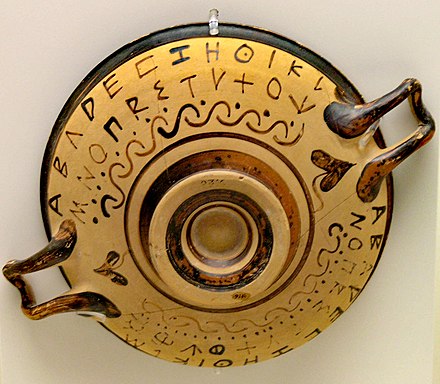Beta
Beta (UK: /ˈbiːtə/, US: /ˈbeɪtə/; uppercase Β, lowercase β, or cursiveϐ; Ancient Greek: βῆτα, romanized: bē̂ta or Greek: βήτα, romanized: víta) is the second letter of the Greek alphabet. In the system of Greek numerals, it has a value of 2. In Ancient Greek, beta represented the voiced bilabial plosive /b/. In Modern Greek, it represents the voiced labiodental fricative /v/ (while /b/ in foreign words is instead commonly transcribed as μπ). Letters that arose from beta include the Roman letter ⟨B⟩ and the Cyrillic letters ⟨Б⟩ and ⟨В⟩.
Like the names of most other Greek letters, the name of beta was adopted from the acrophonic name of the corresponding letter in Phoenician, which was the common Semitic word *bait ('house'). In Greek, the name was βῆτα bêta, pronounced [bɛ̂ːta] in Ancient Greek. It is spelled βήτα in modern monotonic orthography and pronounced [ˈvita].
The letter Β had the largest number of highly divergent local forms. Besides the standard form (either rounded or pointed, ![]() ), there were forms as varied as
), there were forms as varied as ![]() (Gortyn),
(Gortyn), ![]() and
and ![]() (Thera),
(Thera), ![]() (Argos),
(Argos), ![]() (Melos),
(Melos), ![]() (Corinth),
(Corinth), ![]() (Megara, Byzantium), and
(Megara, Byzantium), and ![]() (Cyclades).[1]
(Cyclades).[1]
Beta is used in finance as a measure of (historical; pseudo-implied) financial asset sensitivity to the relevant benchmark index. Conditional on the benchmark index, the resulting beta value can vary considerably (S&P500 vs NASDAQ vs ETF of a specific industry).
Beta should not to be confused with standard deviation (or the semi-variance, which considers only negative returns): the preferred measure of the "riskiness" (historical volatility of returns) of an financial asset or a portfolio in isolation.
Beta can be calculated as the covariance of an financial asset (or portfolio) with its benchmark index, divided by the variance of the benchmark index. Since the industry of finance gravitates towards return generating activities, typically the historical returns (percentage changes) are used in the calculations Beta values (among others). There are numerous other methods an financial analyst can employ to derive Beta values if historical prices are not available. Beta values change over time (company restructuring; industry sentiment; endo/exogenous factors). Beta values also vary, conditional on the time period used in calculating a Beta value. Beta values can be negative, which infers the existence of financial assets which historically, tended to move in opposite directions to one another by some unit value.It would seem these are the optimal "hedges" to offset market-draw-downs, during periods of market-stress and poor liquidity Beta values can vary dramatically, and previously low or even negative correlations converge to "1".
